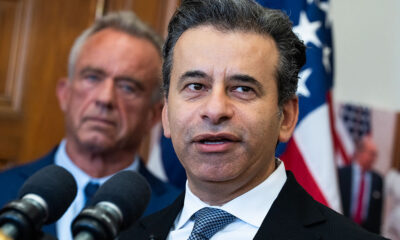Health
Understanding Gynecomastia: Common Concerns of Chest Enlargement

Changes in breast tissue are not limited to women; men can also experience alterations that may lead to concerns about their appearance. According to Dr. Jamin Brahmbhatt, a urologist and robotic surgeon affiliated with Orlando Health and an assistant professor at the University of Central Florida, men often discuss “man boobs” in his office, sometimes with humor and other times with embarrassment. This article delves into the complexities of male breast changes, which can range from harmless fat accumulation to more serious medical conditions.
Commonly, men experience two primary types of breast enlargement: fat accumulation and glandular tissue growth. While the term “man boobs” might suggest a singular cause, the reality is more nuanced. In many cases, men may have both fat and glandular tissue contributing to their condition. Understanding these distinctions is essential for addressing any concerns.
Types of Breast Changes in Men
Gynecomastia, the medical term for breast tissue growth, is often more prevalent than many realize. Research indicates that asymptomatic gynecomastia—growth without pain or tenderness—affects between 30% and 50% of healthy men. This statistic implies that nearly half of all men may experience some form of breast tissue enlargement during their lives, though many may remain unaware of it.
Breast anatomy in men consists of fat and glandular tissue, similar to that of women. The fat contributes to the size and shape of the breast, responding to weight changes, while glandular tissue comprises milk ducts and supportive structures that react to hormonal fluctuations. In women, the hormone estrogen stimulates growth during puberty and pregnancy. In men, testosterone maintains the tissue in a less developed state, yet the basic structure remains intact, allowing for conditions such as gynecomastia.
The fetal development of breasts follows a common pathway for both sexes, beginning with a “female blueprint.” Nipples form before male features develop, leaving men with the same anatomical structures as women. While it may sound surprising, under specific conditions, men can even produce milk. This is typically suppressed by testosterone, but certain medical conditions or treatments can trigger milk production, known as galactorrhea. Although rare and generally harmless, persistent or bloody discharge should be evaluated by a physician.
Understanding Pseudogynecomastia and True Gynecomastia
Men often find that fat accumulation in the chest is the most common reason for a fuller appearance. This condition, termed pseudogynecomastia, occurs when fat deposits accumulate in the breast area. With approximately 40% of men in the United States classified as obese, this condition is increasingly prevalent. Pseudogynecomastia typically feels soft and diffuse, without the firmness or tenderness associated with other types of breast tissue growth.
True gynecomastia, in contrast, refers to the growth of glandular breast tissue beneath the nipple and areola. This tissue often feels firmer and is usually not caused by fat. It typically arises when the balance of testosterone and estrogen shifts, a phenomenon commonly observed during puberty. Indeed, it is estimated that up to two-thirds of boys experience some degree of gynecomastia during this developmental stage, which is usually temporary and resolves on its own.
As men age, changes in hormone levels can lead to renewed instances of gynecomastia. With declining testosterone levels often accompanied by weight gain or medications that alter hormone levels, older men may find themselves at a greater risk of developing this condition.
Various medications, substances, and health conditions can also contribute to breast tissue growth. Medications such as finasteride and bicalutamide can disrupt hormonal balance, leading to breast enlargement. In some cases, discontinuing these medications can reverse the growth. Additionally, the use of alcohol and marijuana, particularly in excessive amounts, can influence hormone pathways.
For those engaged in bodybuilding, anabolic steroids are another potential trigger for breast changes. Thyroid, liver, or kidney diseases can also affect hormone levels, potentially indicating a more serious health concern.
The Psychological Impact and Treatment Options
The psychological effects of gynecomastia can be significant. Many men experience a decrease in confidence, which can impact their posture and social interactions. Some may avoid public places like gyms or beaches, opt for loose-fitting clothing, or feel anxious about intimacy. Dr. Brahmbhatt emphasizes that discussing these concerns is not vanity but rather a healthy approach to a common issue.
For teenagers, reassurance and patience are often the best strategies, as most cases of pubertal gynecomastia resolve naturally. Adults, however, should focus on identifying the underlying cause and exploring appropriate medical, surgical, and lifestyle strategies.
While 1% of all breast cancers occur in men, any new lump or change in the chest should be evaluated by a healthcare professional. Most cases of chest fullness in men are benign, but certain warning signs should not be overlooked. A hard, fixed lump, unilateral breast growth, nipple discharge, or rapid enlargement warrant immediate medical attention.
Treatment strategies vary based on the underlying cause. If a medication is responsible, switching to an alternative may help. Lifestyle changes, such as reducing alcohol or steroid use, can also improve the situation. For those with excess weight, weight loss can significantly impact pseudogynecomastia, often resulting in a reduction in breast fullness.
In cases of true gynecomastia, surgical options exist for removing glandular tissue and contouring the chest. However, not all individuals opt for surgery. Compression garments can provide a temporary solution, while hormone replacement therapy may benefit men with low testosterone levels. Caution is advised, as excess hormone therapy can exacerbate the issue by converting to estrogen.
Understanding the complexities of breast changes in men can alleviate concerns and help individuals make informed decisions about their health. Engaging in open discussions about these topics can promote a healthier outlook and foster support among peers.
-

 Science1 week ago
Science1 week agoResearchers Challenge 200-Year-Old Physics Principle with Atomic Engines
-

 Politics1 week ago
Politics1 week agoNHP Foundation Secures Land for 158 Affordable Apartments in Denver
-

 Health1 week ago
Health1 week agoNeuroscientist Advocates for Flag Football Until Age 14
-

 Lifestyle1 week ago
Lifestyle1 week agoLongtime Friends Face Heartbreak After Loss and Isolation
-

 World1 week ago
World1 week agoGlobal Military Spending: Air Forces Ranked by Budget and Capability
-

 Health1 week ago
Health1 week agoFDA Launches Fast-Track Review for Nine Innovative Therapies
-

 Top Stories2 days ago
Top Stories2 days agoUrgent Search for Suspect Who Exposed Himself to Teen Girl
-

 Business1 week ago
Business1 week agoMaine Housing Inventory Surges to Post-Pandemic High
-

 Top Stories2 weeks ago
Top Stories2 weeks agoUnforgettable Moments: The Best Victoria’s Secret Performances
-

 Business1 week ago
Business1 week agoSpirit Airlines Cuts Workforce with Furloughs for 365 Pilots
-

 Politics1 week ago
Politics1 week agoIsraeli Air Strikes in Lebanon Kill One, Wound Seven Amid Tensions
-

 World1 week ago
World1 week agoTroops to Enjoy Buffalo Chicken, Thai Curry in 2026 MREs









